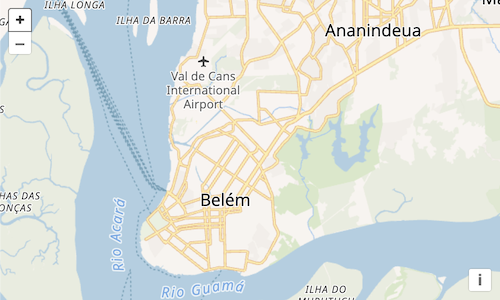Making things look bright
Obviously the map we currently have needs some style. Styles for VectorTile layers work exactly the same way as for Vector layers. The styles described there will work here as well.
For maps like this, creating data driven styles like for vector layers is straightforward. But vector tiles are also being used for street maps, where styling will usually differ a lot depending on the map's zoom level. In these cases, doing all this by hand may be too time-consuming.
In the history of web mapping, there have been many attempts to create tools and formats for styling maps. The most popular formats were probably SLD and CartoCSS. A graphical tool that comes to mind is Atlas Styler. But none of these formats or tools were really convenient to use.
Mapbox finally came up with Mapbox Studio, a very user-friendly style editor, and the Mapbox Style format. The Mapbox Style format is easy to read and write manually, and supported by a growing number of applications. A graphical Open Source editor, Maputnik, is available as an independent alternative to Mapbox Studio for creating and modifying Mapbox Style files.
Using a Mapbox Style definition
With the additional ol-mapbox-style library, there are several ways to use vector tile layers with Mapbox styles in OpenLayers. The easiest is the MapboxVector layer from the ol-mapbox-style import. It is configured with a url that points to a Mapbox Style document. Let's try it out.
First, add the required import:
import {MapboxVectorLayer} from 'ol-mapbox-style';
The tile dataset we are going to use is https://tiles.openfreemap.org/styles/bright. Alternatively, if you have a Mapbox account, you could use the ancestor of that map from Mapbox (see comments in the code below).
const layer = new MapboxVectorLayer({
styleUrl: 'https://tiles.openfreemap.org/styles/bright',
// or, instead of the above, try
// styleUrl: 'mapbox://styles/mapbox/bright-v9',
// accessToken: 'Your token from https://mapbox.com/'
});
map.addLayer(layer);
The above code replaces the VectorTileLayer from the previous step. When everything works as expected, we can finally enjoy a nice looking world map, and zoom in to Belém!

Build a complete map from a Mapbox Style definition
The Mapbox Style format was not just made for styling vector data. It was made to describe an entire map, with all its sources and layers, and its initial view configuration (e.g. center and zoom level).
With ol-mapbox-style's apply() function, it is also possible to create a whole map from a Mapbox Style. If you want to try that, you could replace the whole code in main.js with this:
import {apply} from 'ol-mapbox-style';
apply('map-container', 'https://tiles.openfreemap.org/styles/bright');
After trying this, switch back to the previous code, as we will be looking into how to interact with a vector tile map.